
After my last trip to Singapore I realised that it would have made my life easier if I had found a self-guided tour of Chinatown that allowed me to wander around the area at my leisure. Rather than walking around aimlessly and realising to my regret that I’ve missed some attraction or sight that if I’d know about it before that I would have made a point to visit.
The Lonely Planet guide is a great starting point but unless you have some local knowledge there are always going to be some hidden gems that are off the well-worn tourist trails that you are going to miss. So I’ve tried to include as many of these as well, together with links to the various attraction’s websites so if you feel the need to know more about them the information is at your fingertips.
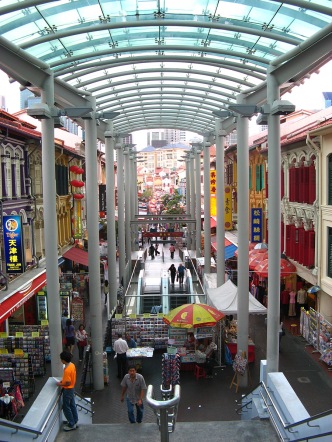
The starting point for this tour is Exit F at the Chinatown MRT station, this will lead you directly onto Pagoda Street, which got its name, erroneously, from the pagoda-like gopuram of the Sri Mariamman Temple at the end of the street. In the early days, Pagoda Street was well known for its opium smoking dens (see the heritage marker at No. 34), it was also one of the stations of the coolie trade between the 1850s and the 1880s (see the heritage marker at No. 37).
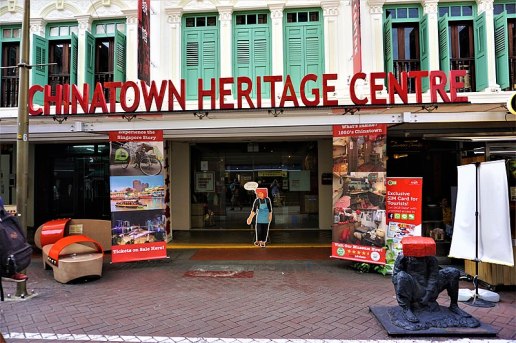
First stop – the Chinatown Heritage Centre, located midway down Pagoda Street. A three-storey recreation of 1950’s Singapore. The ground floor houses a re-created tailor’s shop and living quarters and the first floor a series of lodging rooms, with the audio commentary provides a description of who lived in the cramped surroundings and how they survived. The third floor explains the different aspects of Chinatown, including some of the more unsavoury aspects, the secret societies, opium use, prostitution and slavery. It is really well put together and gives you a unique perspective on Chinatown’s history. Open from 9am to 8pm ($15/adult, $10/child, includes an audio guide)
Second stop – Sri Mariamman Temple, located at the top of Pagoda Street at 244 South Bridge Road. The Sri Mariamman Temple is the oldest and largest Hindu temple in Singapore. Constructed in 1827 and rebuilt in 1843, it has played an important role in the lives of Singaporean Hindus. You can’t miss the traditional technicolor gopuram towering above the entrance. In the early years, it provided shelter for Indian immigrants, and was the only Hindu temple whose priests were vested with the authority to solemnise Hindu marriages. Dedicated to the Mother Goddess, Sri Mariamman, the temple attracted many devotees, who turned to her powers of healing. Today, the temple is best known for the fire-walking ceremony, or theemithi, held annually every October or November. Entry is free and it’s open between 5:30am – noon and 6pm – 9pm (there is however a camera charge/fee). As with most Hindu temples, you will need to remove your shoes and hats, as well as cover bare shoulders and legs.
On the opposite southern corner but on the same side of South Bridge Road is the Masjid Jamae (Chulia). The pale lime green mosque built in the 1830s faces Mecca, and as such is out of alignment with the street grid. The architecture is a blend of the East and the West. While the front gate is typically South Indian, the foyer, main prayer hall, ancillary prayer hall and shrine feature neoclassical colonial elements. Open Saturday to Thursday: 10am-6pm and Friday: 10am-12pm, 2:30pm-6pm; Skirts & short pants are not allowed.

Head back along South Bridge Road then down Smith Street, named after the Governor of Singapore Cecil Smith, which in its heyday used to have a reputation as Chinatown’s red-light (heritage marker at No. 65 – location of one of the most notorious brothels in the area) and food hawker district until the government revamped the area and converted it into the Chinatown Food Street. Keep going past the alfresco tables and chairs until you get to Trengganu Street, where it is worth visiting the Opera House Hotel. This was the site of Laichun Yuen Theatre, (heritage marker) the most popular Chinese opera theatre in Singapore. Chinese Opera used to be hugely popular in the past, as entertainment, for storytelling, and even a means to secretly communicate ideas that went against the ruler or the government. It was also known as a place for secret societies/triads to meet up and negotiate. With the popularity of movies interest in Chinese operas waned and the theatre was abandoned, until it was recently converted into a hotel. Enter into the lobby of the hotel to get idea of the opulence and size of the original theatre.
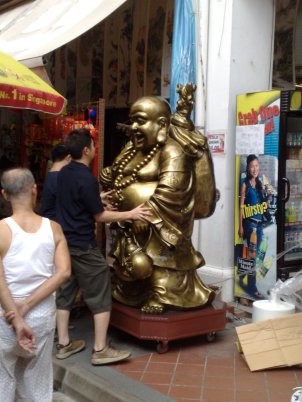
Head down Sago Lane, known as the Street of the Dead due to the death houses that once lined both sides of the street. A death house was literally where the poor came to die. Rooms and dormitories housed the dying, and attached to them were funeral parlours. Medical care was minimal, for those who entered a death house did not expect to recover. On a lighter note rub the tummy of the Laughing Buddha statue at 36 Sago Street for good luck. Visit Nam’s Supplies, at No. 22 Smith Street, who sell paper money and paper models that are burnt as offerings to the dead, which the Chinese use to honour their deceased loved ones during the Qingming festival, or the Tomb Sweeping day.
Next stop – Buddha Tooth Relic Temple and Museum, located at 288 South Bridge Road. You can’t miss this imposing five storey Pagoda style temple. Surprisingly this is a relatively new temple, only opened in 2008 at a cost of $62M. The main entrance is on South Bridge Road where you walk through three large, heavy, red lacquered doors into a small courtyard, with a bell tower and drum tower on either side. From there you enter in the main hall, which is surrounded by hundreds of small Buddha statues, each with different mudras (hand signs) and holding different Buddhist implements or accessories. Above the Buddha statues are one hundred heavenly dragons, providing protection and vitality to all who worship in the hall. Behind the main hall is the Universal Wisdom hall, dominated by a statue of Buddha seated on a lotus flower, make sure you check out the zodiac protectors on the walls surrounding the hall. The mezzanine floor allows you to view down onto the main hall, though the surrounding walls have life sized waxworks of eminent sanghas.
It is however more than just a temple take the lift up to the fourth floor to view the Buddha tooth relic. It is reportedly the left canine tooth recovered from Buddhas funeral pyre and discovered in the remains of a collapsed stupa in Myanmar (Burma). The dazzlingly ornate 2.0m high solid gold stupa in which the tooth relic resides is impressive. No photos however are allowed inside the Sacred Light Hall. Then there’s the museum on the third floor, with its relic chamber at the rear containing samples of Buddha’s skin, blood, hair and large intestine. Make sure you also visit the serene rooftop garden, far above the madding crowds. The centre of this oasis houses a small 10,000 Buddha pagoda and a huge prayer wheel. The temple is open 7am-7pm (viewing of the Tooth Relic is 9am-6pm), entry is free.
Behind the Buddha Tooth Relic temple is the multi-storey Chinatown Complex, the wet market on the ground floor has stalls selling tropical fruit, chinese vegetables, herbs and spices, poultry, fresh meat, crabs, lobsters, cockles, clams, prawns, live frogs, eels and even turtles. Head upstairs to the hawkers market, with over 250 food stalls providing a full range of local dishes from chilli crab, black pepper crab, BBQ stingray, BBQ chicken wings, satay, carrot cake, char kway teow, Hokkien mee, chicken rice, bak kut teh, frog porridge, dim sum, lor mee, prawn noodles to kway chap and pork intestine as well as popular desserts like ice kachang, chendol, tau suan, and soya beancurd. It is impossible to single out any one stall but I’ll put my neck out and suggest you try Liao Fan’s Hong Kong Soy Sauce Chicken Rice & Noodle (#127), Lian He Ben Ji Claypot Rice (#198), and/or Xiu Ji Ikan Bilis Yong Tau Foo (#87), washed down with a beer from The Good Beer Company (#58).
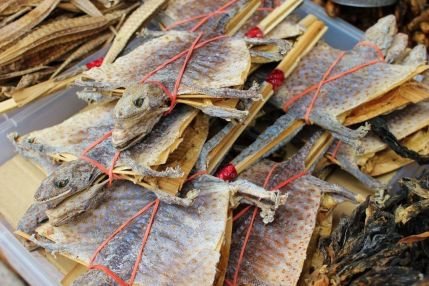
Head back out, past the Buddha Tooth Relic temple to South Bridge Road, cross the street and you’ll find the Teck Soon Medical Hall at 281 South Bridge Road. It is is one of the oldest Traditional Chinese Medicine shops in the area, opening in 1955. It stocks unusual items like dried fungi (cordyceps), bird’s nest, dried mushrooms (lingzhi) and even dried flying lizards and seahorses, as well as traditional Chinese medicinal herbs and ingredients.
Opposite the Buddha Tooth Relic temple, is a giant construction site where the government is building a new MRT station. If you however travel down Erskine Road a 100 metres you’ll find the Maxwell Road Food Centre. With over 150 food and drink stalls this a great spot for lunch. Open 8am-2am daily.
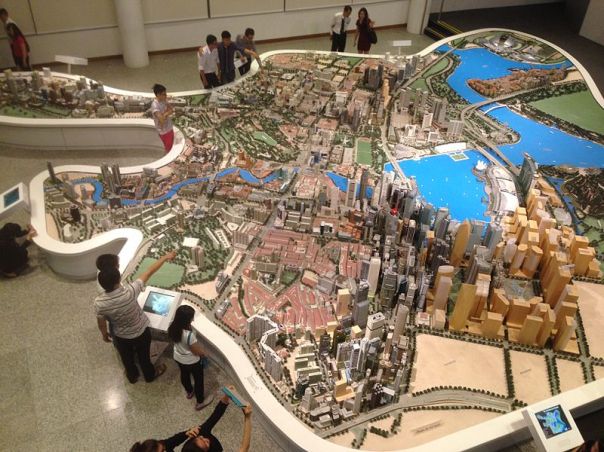
Next stop – Singapore City Gallery, located opposite the Maxwell Road Food Centre, in the Urban Redevelopment Authority Building at 45 Maxwell Road. This 3 storey visitor gallery showcases Singapore’s physical transformation in the last 50 years. Whilst the main feature is the 11 metre by 11 metre architectural model of central Singapore, which is amazingly detailed & intricate, the audiovisual and interactive exhibits on the third floor highlight the city’s physical transformation past, present and future. A must for people interested in architecture and town planning or if you want to learn more about how the city was planned and developed over the years as well as it’s plans for the future.
Head out along Kadayanallur Street until you get to Ann Siang Road, wander up the street past the tightly packed terrace houses and shops with their art-deco tiles, which once housed Chinese Guilds and shops containing letter writers and calligraphers. Make sure you take a peek at No. 46, which houses the 140+ year old Lee Clan Association. In the past when immigrants arrived in Singapore many of them found that they had nowhere to go and decided to set up clan houses, which were classified by dialect, trade, or in this case, surname (which implies they came from a similar lineage or province). These places aimed to provide assistance to immigrants, especially businessmen and workers who came to the country alone. It was almost like finding a family in a foreign place, because you would share similar surnames and even dialects in the same clan. Sadly, almost all the clan houses have closed or moved out of the area, due to the gentrification of the area.
At the top of the street is Ann Siang Hill, the highest point in Chinatown, it used to be a spice hill, where nutmeg, cloves and cinnamon were grown. In fact, there are still a couple of cinnamon trees around, which you can spot on the red-lined walkway after entering from the Ann Siang Hill Park entrance at Ann Siang Road. You can also see the last remaining water well in Singapore here, from which water was drawn and transported by bullock carts throughout the city.
Traverse through the park to Amoy Street, walk down past the giant mural depicting the life of Singapore’s early Hokkien settlers. Located between Amoy and Telok Ayer Streets there is a small park, Telok Ayer Green, where you can see sets of sculptures, which depict the way of life in the early days of Singapore. Check out the Chinese lantern procession, Indian milk traders and the sampan figurines while taking a leisurely walk through the park. Telok Ayer literally means “bay water” in Malay, as it formed the original shoreline of Singapore, where boats came to replenish their water supply and off load their cargo of Chinese immigrants.
Next stop – Thian Hock Keng Temple, located at 158 Telok Ayer Street, built in 1839 the temple is the oldest and most important Hokkien temples in Singapore. With its origins as a humble joss house in 1821. It was erected in honour of Mazu, goddess of the seas, the first stop for Chinese immigrants to offer thanks for a safe voyage. The temple was constructed with all the building materials brought over from China, using traditional techniques, with no nails in any part of the main structure. Like many Chinese temples, Thian Hock Keng has the standard layout of a three-hall typology, comprising an entrance hall, a main hall, and a rear hall. In addition, it has additional rows of side halls on either side of the primary prayer halls. Apart from Mazu, other deities worshipped here include Baosheng Dadi(God of Medicine and Health), Guansheng Dijun (spiritual protection), Confucius (a favourite among students and their parents, particularly at exam time), and the Goddess of Mercy. Open 7:30am-5:30pm, entry is free.

Located immediately adjacent to Thian Hock Keng temple, is Gong Wen Ge (Institute for the Veneration of Literature), at 168 Telok Ayer Street, which is generally not frequented by the hordes of tourists visiting the temple. In the mid 1850s, people would flock to it’s impressive three-level wooden pagoda (with a wrought iron spiral staircase c.1880) to burn unwanted written materials such as old letters, medical slips, bills and auspicious banners. The folk custom was conducted at Chong Wen Ge in reverence to the deity Cang Jie– the legendary inventor of Chinese characters. In 1950 the adjoining two-storey building became the Chong Hock Girls’ School run by the temple, but it has since been converted into a tile gallery and café serving Peranakan cuisine (open 11:00am-5:30pm). Also sharing the building on the second floor is the Singapore Musical Box Museum. Open Wednesday to Monday 10:00am-6:00pm – adults $12, children u/6yrs free.

On the other side of the Thian Hock Keng temple, at 150 Telok Ayer Street, is the Singapore Yu Huang Gong – Temple of the Heavenly Jade Emperor (or former Keng Teck Whay Association building). The Keng Teck Whay Association founded in 1831 was an exclusive members’ club. For acceptance to the association, each member had to pay 100 Spanish Dollars and membership was entitled only to the eldest male descendant of a deceased founding member. The building fell into disrepair in the 1990s and was acquired by the Taoist Mission (Singapore) in 2010, who spent five years restoring the building to its former grandeur, re-opening it as a Taoist temple. Its three-level pagoda mirrors the pagoda at the Gong Wen Ge building forming a perfect symmetry resulting in most visitors mistaking the three buildings as one entity. Open 9am to 6pm daily, though no shorts or mini-skirts permitted.
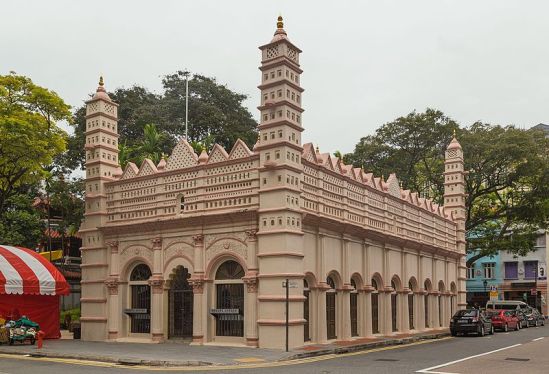
Nagore Dargah, located adjacent to the park next to the Thian Hock Keng Temp, at the corner of Telok Ayer and Bon Tat Streets. Built in 1830 as a shrine to Nagore Shahul Hamid, by Muslims from southern India. The building resembles a multi-tiered wedding cake, with its sharp arches decorated with intricate moldings. Unlike most dargahs it is not built over a tomb nor did it contain any bodily relics. In 2007 it was converted into a Indian Muslim Heritage Centre, outlining the history of Indian Muslims in Singapore. Open weekdays 10am-5pm and entry is free.
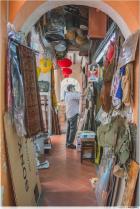
As you continue along Telok Ayer Street, make sure you stick your head in the shop at No. 128, Odds ‘n’ Collectables, it is crammed with an amazing collection of odds and ends, vintage and antique items and collectibles.
Keeping walking down street, to the Ying Fo Fui Kun building at 98 Telok Ayer Street, which houses the Hakka Clan Association (one of the oldest Clan Association buildings in Singapore). It was initially constructed as a temple in 1881 but then converted into a Clan Association, aiming to help new Hakka immigrants to settle down in Singapore. It is still in operation today.
Next stop – Fuk Tak Chi Temple, at 76 Telok Ayer Street, which is the oldest Chinese temple in Singapore, built in 1824 by Hakka and Cantonese immigrants, dedicated to the Chinese deity, Tua Pek Kong(god of Wealth), who is worshipped by both Confucianists and Taoists. In the early 1990s the temple fell into disrepair and was handed over to the government. In 1998, the building was restored and converted into a street museum with artifacts on the lives of early Chinese migrants in Singapore, which also forms part of the Amoy Hotel lobby. Open seven days 10am-10pm, free entry.
Keep walking to the end of Telok Ayer Street and then make a small dogleg across Church Street to Phillip Street.
Last stop – Yueh Hai Ching Temple also known as Wak Cheng Bio Temple, at 90B Phillip Street, whose name literally means “Temple of the Calm Cantonese Sea” was the first stop for Chinese immigrants to Singapore in the early 19th century. Built in 1826 it is one of the oldest Taoist temples in the city. The temple is situated within a walled compound fronted by a main entrance gate leading to a spaciou8s forecourt. Whilst it is dwarfed by the modern skyscrapers that surround it, it provides a quiet sanctuary from the hustle and bustle of the financial district. There are two halls in the temple, with Tian Hou Gong(Palace of the Heavenly Empress) occupying the left and Shang Di Gong (Palace of the Heavenly Emperor) to the left. The temple however is more commonly known to locals as the “Love Temple”, with many romantics tying or draping a red string around Yue Lao, the Chinese god of marriage, one of the many deities housed at the temple, inthe hope that he will find them the future love of their life. Open 8am-5pm, entry is free.
From here you can either backtrack to Telok Ayer Street and jump on the MRT at the Telok Ayer station (just before the intersection of Cross Street) or continue to the end of Phillip Street, cross the street and walk through the atrium under the United Overseas Bank (UOB) Plaza (past by Salvador Dalí‘s statute, Homage to Newton) to the banks of the Singapore River and Boat Quay. Another alternative is when you get to the end of Phillip Street turn right onto Battery Road and walk down to the Raffles Plaza MRT station.
For those who are adventurous and have the time to see one more relatively unique temple, seldom visited by tourists, then either walk all the way back to Maxwell Road, past the Singapore City Gallery and down Peck Seah Street or catch the MRT to Tanjong Pagar station and walk down Choon Guan Street to Peck Seah Street.
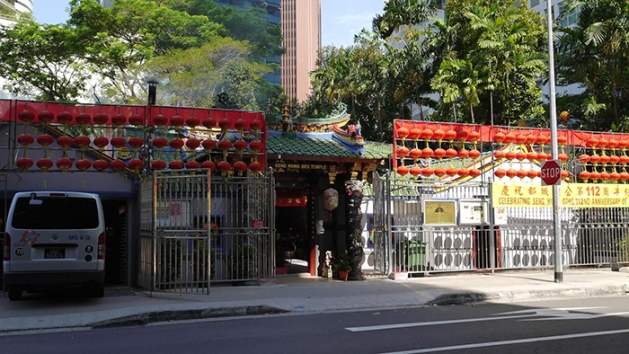
Extra Stop – Seng Wong Beo Temple, hidden at the end of Peck Seah Street, this Taoist temple was founded in 1898 originally and rebuilt in 1905, is dedicated to the City God, Chenghuangshen, who is not only responsible for the well-being of the metropolis but also for guiding the souls of the dead to the underworld. One of the key functions of this century old temple apart from looking after the spirits in the city, is to perform ghost marriages. A ghost marriage is one which parents of children who died young arrange a marriage for their deceased loved one in the afterlife, a practice now officially banned in China. Free entry and open between 8:00am and 5:30pm.
If you are interested in exploring more of Singapore – check out my walking tours of Little India and Kampong Glam.
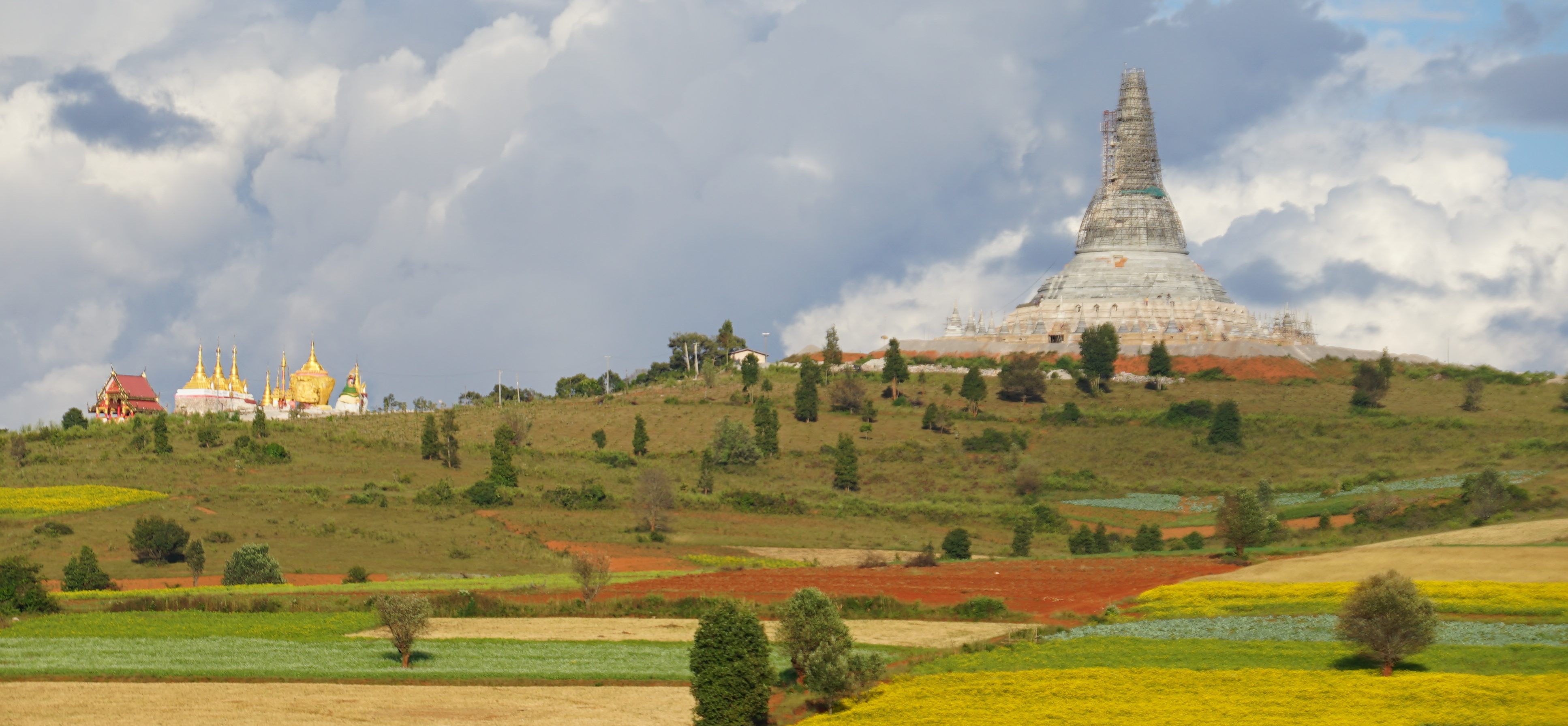







































How long does this walk take?
It depends upon how long you take wandering around some of the temples, markets etc. You can easily do it in half a day, 4-5 hours.